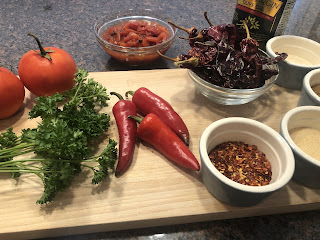Origins of Algerian Harissa
Harissa, this Algerian staple, has been increasing in popularity in recent years and all over the world. But what is harissa, and what are its origins?
The ingredients of this hot and spicy paste can vary depending on where it is made, but a standard version includes a blend of hot chili peppers (often smoked), garlic, olive oil, tomatoes, and a blend of spices including cumin, coriander, caraway and mint. The name harissa comes from the Arabic word harasa (هَرَسَ), which means to mash or pound, as the ingredients are traditionally pounded together to form a thick paste. It can be used as a condiment – delicious between a fresh baguette and grilled merguez sausages, but also as a marinade for meat and fish, or a base flavoring in stews or sauces. Fairly popular in France, it has spread to all of Europe and beyond. It is now available in many grocery stores in the United States.
While the origins of harissa are strongly rooted in North Africa, the history of this sauce can be traced to an entirely different part of the world. The chilis responsible for its signature kick are actually native to Central America. Archeological sites suggest that chilis were consumed in Mexico, having been cultivated by the Incas, Mayas, and Aztecs. With the arrival of the spice-seeking Spanish and Portuguese to the Americas, it was not long before chilies were being shipped back to Europe and, eventually, to Spanish and Portuguese colonies in Africa, India, and Southeast Asia. Over the next 500 years, chilis would go on to excite the taste buds and the imagination of cooks all over the globe, in just about every culture. In North Africa, they led to the creation of harissa.
Most historians agree that chili peppers were first introduced in Africa as a result of the Spanish occupation of Tunisia in 1535-1574. It was around this time that chili peppers began to be sold in souks (markets). Much of today’s Algerian harissa output comes from the northeastern region of the country, Annaba, a leader in the agricultural and agro-food industry. The industrial cultivation of tomatoes is very developed in Annaba, making it a major producer of Harissa as well. However, neighboring Tunisia remains the largest exporter of harissa in the world.
Today, prepared harissa is sold in jars, cans, bottles, and tubes. As any Algerian will tell you, each batch will taste unique, as each recipe boasts a slightly different blend of spices and ratios of each of the main ingredients. With subtle differences between batches, harissa can be quite spicy, but not overpowering – scoring 40,000–50,000 on the Scoville scale (for reference, Sriracha is between 1,000-2,500). To find the perfect harissa for your liking, the best approach is to make your own. The base recipe is quite simple and offers many opportunities to add your own signature flair. Check out this recipe to make your own at home!


Comments
Post a Comment